Making Brioche Polonaise
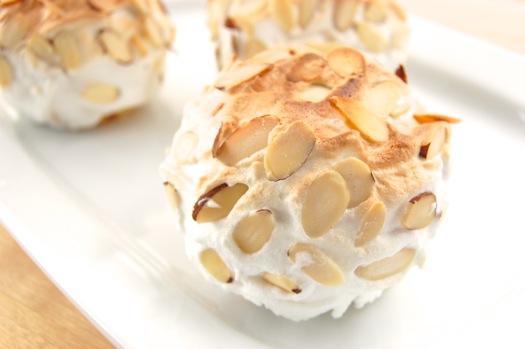
I’ll admit it, fancy pastries can be scary. You see a lengthy list of make-ahead components and you wonder: when I finally get to the end of this road will it all be worth it? Will it really be different and special? Or only marginally better than something I can buy in a shop? Legitimate concerns, all. I can tell you that brioche polonaise is one of those sweet mother of God pastries. It does have several components, all of which you’re better off making yourself. Most will keep for many days ahead of time. Make one each day for three or four days and the final assembly and bake is pleasantly low-stress. You’ll love the process and feel proud when it’s done. Ready? Then let’s begin.
You’ll need about 6 brioche
About two cups of diplomat cream (the pastry cream can be made ahead)
About half a cup of chopped candied citrus peels (without the final coating in granulated sugar)
About a cup of simple syrup spiked with 2 tablespoons kirsch
Half a recipe of Italian meringue
About half a cup of sliced almonds
I baked up some brioche à tête but without the tête. I mean, why torture myself? I’d just cut the heads off anyway. I used about two ounces of brioche dough for each. These freeze very well if you want to make them ahead of time. They’re easier to work with if they’re frozen, which is another benefit. See how they’re already almost a ball to begin with?
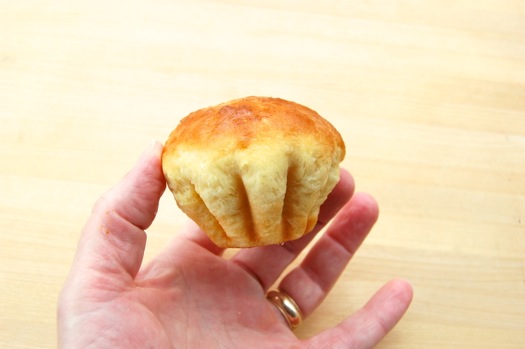
Cut a slice out of the middle like so.
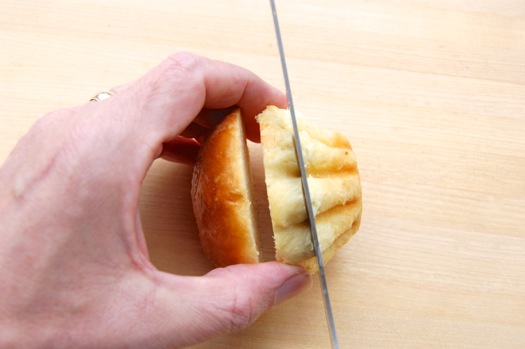
Lay the slices out and brush them with your kirsch syrup. Two or three sops should do it.
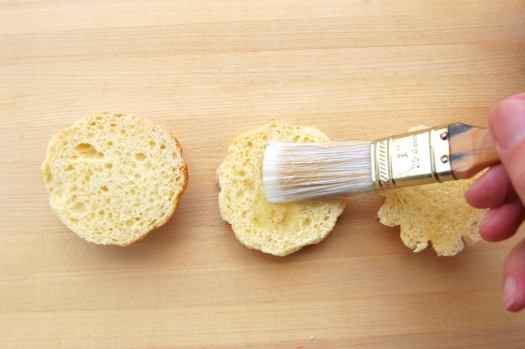
Spoon on some diplomat cream.

Ah, did I mention an earlier step where I folded about 1/3 cup of chopped candied orange and lemon peels into two cups diplomat cream that I’d just made? I’m starting to think I didn’t. So do that.
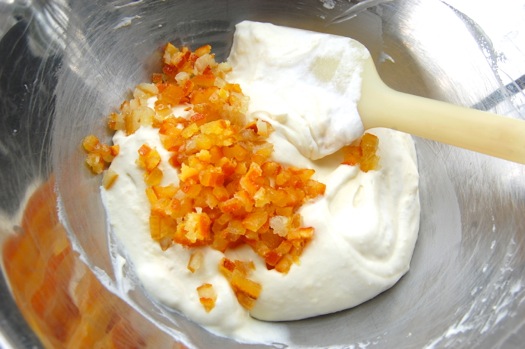
Reassemble your brioche.
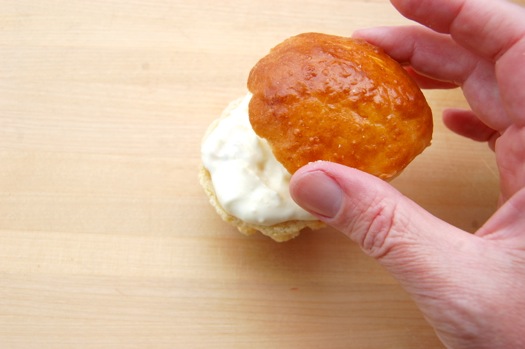
Nice little double decker sandwich, yes? And even more ball-like.

Put those out on a pan lined with parchment and freeze them for about two hours. Overnight will work just fine as well.

On the day you’re planning to serve them, add the layer of Italian meringue. With the brioche frozen, this is very easy to do, though you’ll make a little bit of a mess. Just apply a thin coat, just so you can’t see the brioche crust anymore.
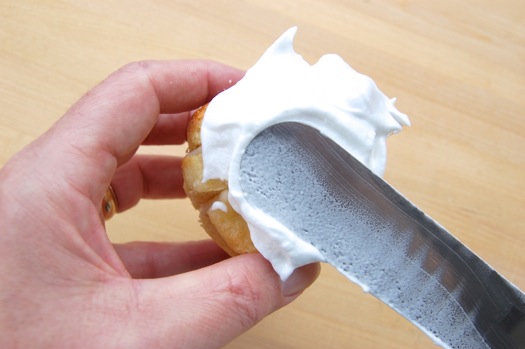
Put the coated brioche on a sheet pan without parchment (you don’t want to burn your house down) and dab the top. Now we really do have a ball, no?
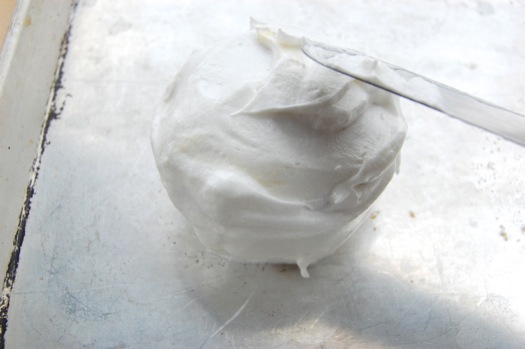
Stick on a bunch of sliced almonds. At this point you can hold the pastries in the fridge until you’re ready to toast and serve them. Or you can toast them now and serve them a couple of hours later. Freshly-toasted is better though.
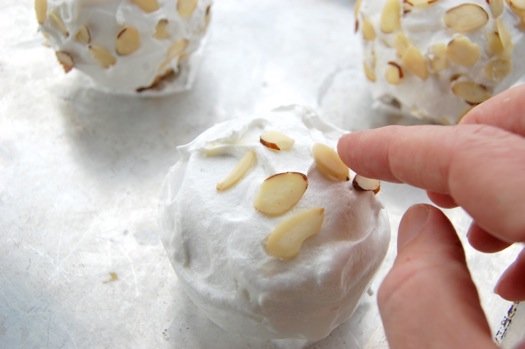
Put them under the broiler only for as long as it takes to toast the meringue. Depending on how hot your broiler is, it won’t take long. Watch them the entire time. I used a low broiler to sort of “bake” these for about two minutes, then turned it up to high for the final toast, which took about 20 seconds. Gently remove them from the hot pan with an icing spatula and arrange them artfully on a plate (or plates). Watch guests pass out.

You won’t believe how these taste. Creamy, cake-y and sweet but not cloyingly so. A touch of bitterness from the candied peel. Almond for sophistication and crunch. Kirsch for a white-tie-and-tails sort of finish. Whoa momma. You’ll be talking about these for a while. Here’s what they look like on the inside:

I suppose I could have made my filling layers a touch thicker, but this was still a very nice balance. Interestingly the chewy candied fruit rinds become almost jelly-like after a few hours immersed in the pastry cream. Delectable.
I experimented with some different shapes because I was concerned the ball shape might be too challenging. Silly me. This is two ounces of brioche dough baked in a popover pan. How did these turn out?
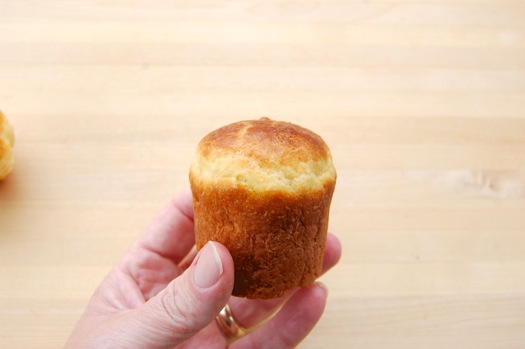
Not bad. The sphere shape is better I think. But hey, I gave it a shot.
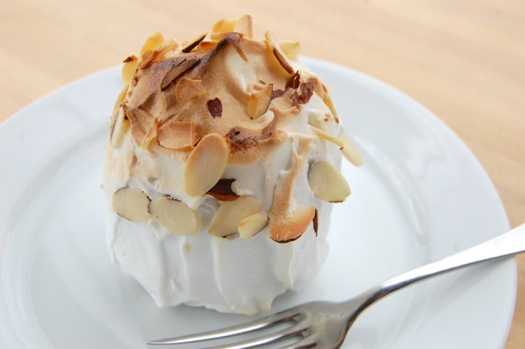
Oooh la la!! Very nice indeed. Is the texture cake-like enough to eat it with just a fork? Does the filling make it somewhat slippery? (I’ve never even heard of these things before, much less eaten them.) They’re lovely.
Thanks so much, Chana! They were fun!
– Joe
Oh and yes, a fork is all you need for these. They do adhere together, probably because of the syrup.
– J
Goodness Gracious! You have been a busy man today! I can hardly keep up! Like Chana, I have never heard of these before, but they look delicious and anything that rates a “sweet mother of God” certainly has my attention. 🙂
wowzer…they look awesome.
These looked intimidating at first but like you said in steps not quite as complicated. Might have to try them some day. I have made small brioche like that before and not only are the cute but tasty. This project looks like it would take those to the next level…and beyond.
Oh yes, indeed so. The components are all pretty straightforward. As you know brioche is a very forgiving dough, pastry cream is a snap and the candied rinds just take a little time. So there’s nothing tricky here, it just takes a little intestinal fortitude when it comes to assembly. I found it fun, but I’d be lying if I said I wasn’t a little nervous at the outset. I wondered if the meringue wouldn’t just drip off. But it didn’t. As is so often the case, I worried for no good reason.
Cheers,
– Joe
Just found your recipe page. Have made brioche polonaise in the past and they’re to die for. Sort of time consuming but well worth it.
Will certainly be looking forward to more of your recipes.
Hi Connie!
Yes, I love those things. I can’t wait to make them again. Thanks and let me know if you have any questions about anything you find here. Cheers,
– Joe
Hi Joe,
These look amazing, and I really want to try them. I have two questions for you:
Does the diplomat cream hold up in the freezer without gelatin? And, do you think these could be torched instead of baked on broil?
thanks!
Hi Joe!
Yes to both! Let me know how you like them when you’re done!
– Joe
Hi Joe,
They came out great! I substituted a bit of lemon cream for the candied peels, as I had the former handy and not the latter. I also tried using a torch, but the outside browned much too quickly, leaving a still-gooey meringue between the shell and the brioche. Ended up going with the broiling technique.
thanks for the recipe and for the help
Glad I could be of assistance, Joe! I’ll remember that about the torch. Makes sense, but until someone tries it you never really know. I depend on readers for this sort of testing! Cheers and thanks!
– Joe
My broiler doesn’t have room for these. Could I brown them with a blow torch as in browning a baked Alaska?
You certainly can, Donna!
– Joe